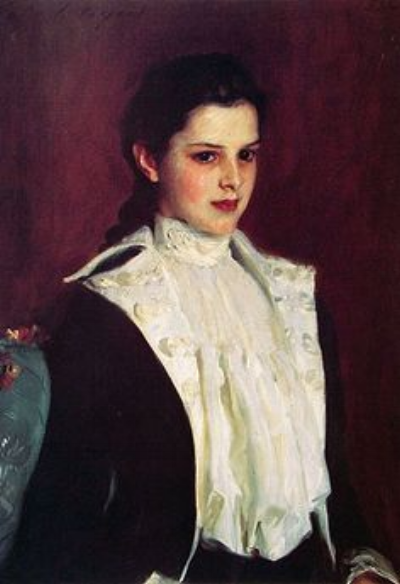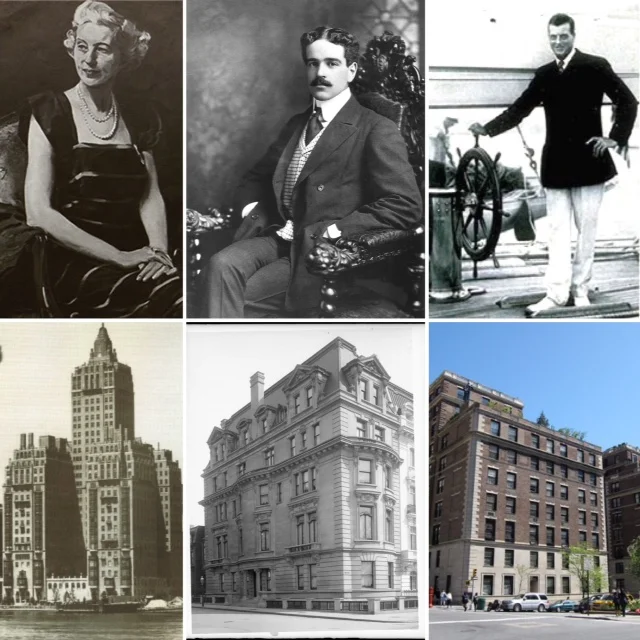The Myriad Manhattan Residences of the Vanderbilt Cousins Part One: The Children of Cornelius Vanderbilt and Margaret Vanderbilt Shephard
Part One: The Children Cornelius Vanderbilt and Margaret Vanderbilt Shephard
The eight offspring of William Henry Vanderbilt set the benchmark for luxurious living in gilded age New York, forever intertwining the name Vanderbilt with opulence and wealth. Nowhere was this more evident than in their palatial Manhattan residences,which were instrumental in transforming the fashionable precincts of Fifth Avenue from a thoroughfare of brownstone sobriety into a marble and limestone clad Epcot of fantastical mansions, derived from every imaginable historical style. While few of these urban palaces managed to survive their owners, succumbing to the swiftly changing modern word around them (see earlier post). a more tangible legacy survives through the many homes of their children. Taking up the mantle from their parents generation as leaders of New York's smart set, most of the Vanderbilt "cousins" established themselves in luxurious abodes of their own.
Given their sheer numbers and relatively young ages (not to mention some of their parents’ propensity for spending the majority of their own fortunes) few had the resources to build mansions on quite the same grand ducal scale as the generation before them. Fortunately, grand townhomes were often the parental nuptual present of choice. Others took a more modern tack, taking up housekeeping in the luxury hotels and apartment buildings that were becoming socially acceptable alternatives to maintaining a house in town. Although by and large most of these Vanderbilt domiciles were a step down in splendor from those of the generation before them, they were nonetheless undeniably impressive.
The Children of Cornelius Vanderbilt
Cornelius Vanderbilt, the eldest of William Henry's children, was one of the principal heirs to his father's fortune, residing at the fabled, now demolished 1 West 57th St. with his wife and seven children.
Upon his death, he left his second oldest son Alfred at least $42 million, with another $30 million to be split equally between his wife and three of the four remaining children (two had predeceased him). This left his eldest surviving son and namesake Cornelius Vanderbilt Jr. out in the cold with a comparatively paltry $1.5 million.
Cornelius incurred his father’s wrath, and subsequent financial exile by marrying the effervescent Grace Wilson, of whom the family strongly disapproved. Despite this, the young newlywed couple was able to live and entertain quite handsomely all the same thanks to the largess of Mrs. Ogden Goelet, Grace’s elder sister who loaned them use of her seldom-occupied Goelet Mansion at 608 Fifth Avenue.
Goelet Mansion in 1925
After their father died, Alfred settled another $6 million on him to avoid any legal challenge to the will, bringing his fortune up to the same level of the other younger siblings, allowing he and Grace to establish themselves in spacious townhouse of their own at 677 Fifth Avenue, smack dab in in the heart of Vanderbilt Row.
677 Fifth Avenue while owned by the Vanderbilts
In 1914 Grace and Cornelius serendipitously inherited one of the largest of the family’s homes, 640 Fifth Avenue, from his Uncle George's estate (more on that here). Eager to live on the regal scale they (well, primarily Grace) thought they were due, they wasted little time in having society architect Horace Trumbauer extensively remodel the 640 and put 677 on the market. With the business invasion of Fifth Avenue in the 50’s well underway, it was sold to developers who soon razed it and erected a commercial building in its place, today home of Fendi.
Fendi at 677 Fifth Avenue
Gertrude Vanderbilt
Gertrude Vanderbilt Whitney
Cornelius and Alice's eldest daughter, had the (financial) good fortune to marry Harry Payne Whitney whose family was just as rich as the Vanderbilts and literally grew up across the street from her in a multi-gabled mansion at 2 West 57th Street.
Whitney Mansion, with Vanderbilt Chateau in the foreground
Harry's father gave the newlyweds the house as a gift, where they lived for a number of years. As grand as her home was, Gertrude moved up another notch on the architectural scale after her father-in law's death, when she and her husband acquired his former home at 871 Fifth Avenue, an urban palace on the same scale as 640 Fifth Avenue .
871 Fifth Avenue
She resided there until her death in 1942, after which the mansion was soon razed.
Alfred Gwynne Vanderbilt
The principal heir to his father’s estate, certainly had the financial wherewithal to build a mansion along the same lines as those occupied two older siblings, but didn’t. He was cut from a different cloth. While he and his wife initially established themselves in a mansion at Fifth Avenue and 56th street, they jettisoned it and were among the first guests to check into the newly opened Plaza hotel just north of his mother’s chateau (for all of Alice’s severe reputation, her children definitely stuck close to home geographycally!).
Plaza Hotel with Alice's chateau in the foreground
Although he leased townhouses from time to time in the city, he never bought another or built one, preferring to live in hotel suites, the last one in the Vanderbilt Hotel before his tragic early death on the Lusitania in 1915.
Reginald Vanderbilt
The youngest daughter Gladys (in true gilded age heiress form) married a titled nobleman and established her residence in Budapest, which left the youngest son Reginald ( better known today as the father of Gloria Vanderbilt).
A raffish rake with a weakness for horses, women and gambling (not necessarily in that order), he managed to spend every cent he inherited not held in trust. Although he was constantly in financial trouble, and often had to be bailed out by his mother, he managed to live quite handsomely. He and his first wife began their married life by leasing this handsome 5 story townhouse at 22 East 72nd St.
At the time his death 20 years, later, he was living with his 2nd wife, the former Gloria Morgan in this townhouse nearby at 12 East 77th street, which had to be sold rather quickly to pay off his debts. Recently it was the Brandeis University Alumni House.
These interior shots, taken when Brandeis put the building on the market in 2014, give a little hint of just how nice life was like for one of the "poorest" of the Vanderbilt cousins!
The Children of Margaret Louisa Vanderbilt Shepard
The eldest of William Henry’s daughters could not have had a more contrasting financial situation to her brother Cornelius. Her husband Elliot Fitch Shepard, managed to blow through the entire $5 million dollar cash portion of her inheritance by the time he died in 1893, leaving her with roughly a million dollars worth of real estate and physical property (primarily purchased with her money) and the income from her $5 million dollar trust fund to live on. But, oh what that income from the trust could buy!
Maria Louisa Shepard Schiefflin
When it came time Margaret’s eldest daughter Maria Louisa to marry William Jay Schiefflin in 1891 Mrs. Shepard gave the couple quite a handsome fully furnished townhouse as a wedding present at 35 West 57th St., which still stands today. Although the ground floor has been altered for commercial use, the upper floors can give one an idea of the grace and scale of the home. Even more impressive, several years later Margaret purchased 2 sets of adjoining brownstones at 5 East 66th Street and 11 East 62nd street. On the 66th street site, she had the architectural firm of Hunt and Hunt erect an elegant, doublewide French Renaissance mansion, which she gifted to the Schiefflins.
Schiefflin Mansion today
They lived there until 1925, when they decamped for an apartment in 620 Park Avenue.
640 Park Avenue
Edith Shepard Fabbri
Edith and Ernesto Fabbri
On the 11 East 62nd street site, an even grander, more baroque mansion rose, which Margaret in turn gave to her daughter Edith, who had married Ernesto Fabbri. The Fabbris lived in the house until they moved to Europe for several years, leasing their mansion to the Harrimans, the Ledyard Blairs, and their cousin Alfred among others.
After their return to America, whether tired of the baroque excess of their mansion, or inspired by the pared down style of villas in Italy, the couple decided to sell their home in 1912 and bought a large lot at 7 East 95th street. On this site, architect Grosvenor Atterbury designed a pared-down, handsome red brick mansion for the couple.
fabbri Mansion today
In 1949, Edith Fabbri deeded the house to the Episcopal Church, which today serves as the House of the Redeemer. Meanwhile, the Fabbri’s original mansion also went through a series of owners, and today is owned by the Japanese Government.
Alice Shepard Morris
Alice Shepard portrait by John Singer Sargent
Margaret’s youngest daughter Alice married Dave Hennen Morris in 1895. Margaret strongly disapproved of the marriage and the couple essentially eloped, so no grand mansion was in the cards as a wedding gift. Quite on their own and quite contentedly, the couple set up housekeeping on the Upper West Side, which to a Vanderbilt must have been social Siberia, in a townhouse at 269 West 72nd street. Margaret, for all her conventions, was a kind woman who loved her daughter and eventually the relationship was healed. In 1909, the Morris’s were snugly back in the family fold, and snugly living in a new, handsome Italian Renaissance townhouse on East 70th street.
Morris Mansion today
The only son of the Shepard family, Elliot Jr, spent a great deal of time in France, and died in Miami. I could find no record of any Manhattan residence. The sisters’ homes however, all stand remarkably intact today – collectively they show how grandly people could live on a few million dollars a hundred years ago!. For more specific reading on some of them, I suggest checking out the following links, on Big Old Houses, and Daytonian in Manhattan

































